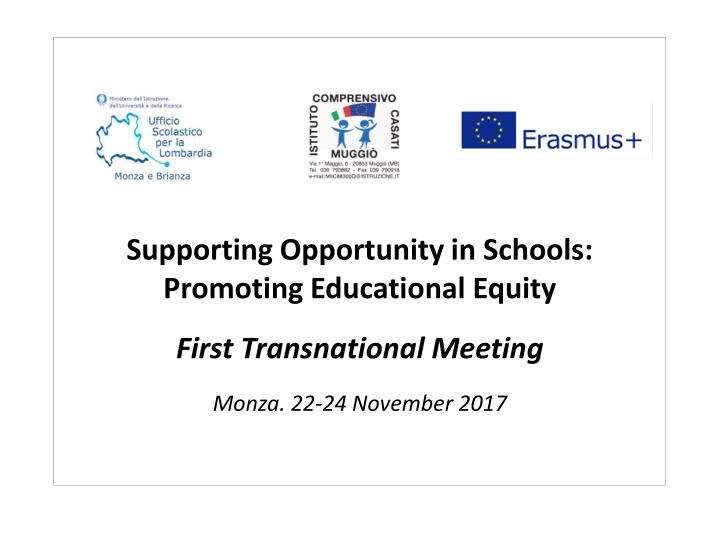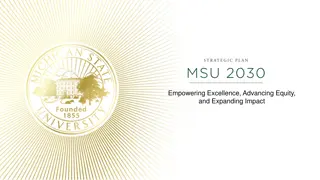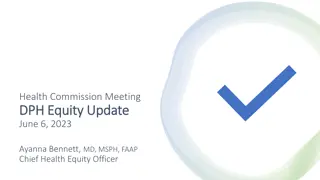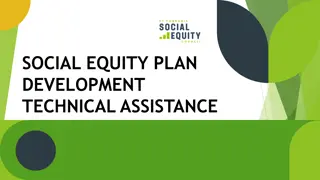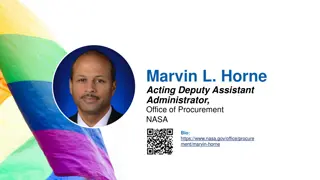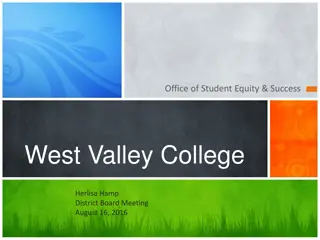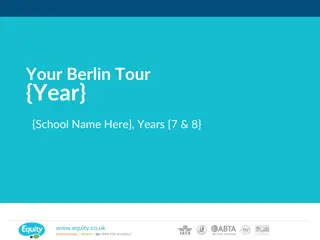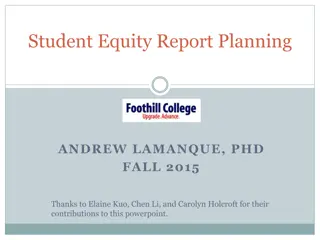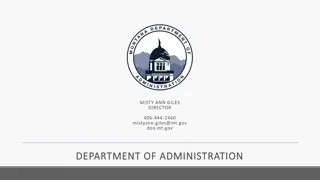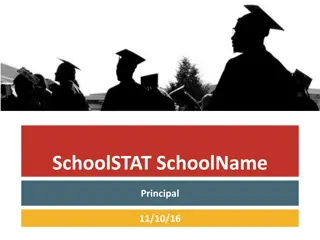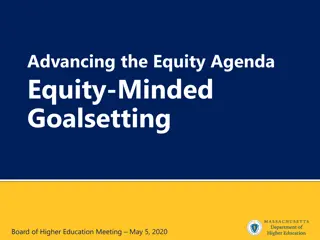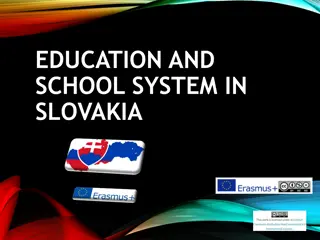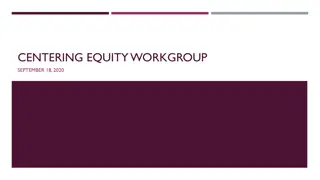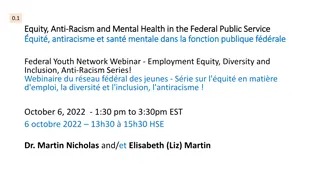Supporting Opportunity in Schools: Promoting Educational Equity
Development of inclusive education in Italy is rooted in the Constitution, laws, and policies that guarantee school for all, focusing on inclusion of students with disabilities through various legal frameworks. The transnational meeting held in Monza discussed the critical issues and the need for rethinking aspects of the educational system for promoting equity.
Download Presentation

Please find below an Image/Link to download the presentation.
The content on the website is provided AS IS for your information and personal use only. It may not be sold, licensed, or shared on other websites without obtaining consent from the author.If you encounter any issues during the download, it is possible that the publisher has removed the file from their server.
You are allowed to download the files provided on this website for personal or commercial use, subject to the condition that they are used lawfully. All files are the property of their respective owners.
The content on the website is provided AS IS for your information and personal use only. It may not be sold, licensed, or shared on other websites without obtaining consent from the author.
E N D
Presentation Transcript
Supporting Opportunity in Schools: Promoting Educational Equity First Transnational Meeting Monza. 22-24 November 2017
Italian policies for inclusion and equity at school
Development of inclusive education Italian Constitution The Italian Republic guarantees school for all (Article 34) and requires that the mandatory duty of solidarity be fulfilled (Article 2). Moreover, it is the duty of the Republic to remove any obstacles constraining the freedom and equality of citizens in order to ensure the full development of the human person (Article 3) After so many year of inclusion our country is now considering the critical issues and the need to rethink some aspects of the entire system Maristella Colombo, Duilio Fenzi UAT Monza e Brianza 3
Development of inclusive education Law 118/71 Law 517/77 Children with disabilities integrated in normal classes at school Law 180 /78 Law 104/92 More rights for people with disabilities DPR 24 February 1994 2009 ONU Convention Disability 2009 Guidelines for the Inclusion of people with Disabilty L. 170/2010 recognises dyslexia, dysgraphia, dysorthographia and dyscalculia as specific learning disorders. The Ministerial Directive 2012, Measures for pupils with special educational needs and guidelines for school inclusion , Maristella Colombo, Duilio Fenzi UAT Monza e Brianza 4
A few elements to understand: The inclusive organizational system The best inclusion practices INCLUSION OF ALL STUDENTS HOW? The school assumes responsibility to recognize the real needs of inclusion The school activates resources for inclusion according to the "special normality" approach the school elaborates models of inclusion and spread an inclusive culture Maristella Colombo, Duilio Fenzi - UAT Monza e Brianza 5
THE KEYNOTES OF INCLUSION Accept diversity: diversity is essential to all human beings . Assure active participation: inclusion does not mean finding a place in the classroom. Being inclusive means a continuous effort to assure an active participation of the student as a learner and as a social being. Develop cooperation practices: inclusion is a continuous process which requires the support of all those who are interested in it. Imagine a different school: an inclusive school is a different school which learns from its own experience and promotes continuous change and development.
Inclusive and effective classroom practices Solutions which are transferable across a wide variety of situations Practices working in any different situation (Canevaro, Ianes) Practices which reach the expected goals Practices tending to develop a life project (Canevaro) Useful practices ( Fornasa) Practices tending to a special normality approach (Ianes) Normal practices tending to preserve differences (Booth e Ainscow ) Nowadays we need to implement inclusion The idea of students welfare has changed too Maristella Colombo, Duilio Fenzi - UAT Monza e Brianza 7
A new prospective ICF : International Classification of Behaviour, Disability and Health BEYOND THE MEDICAL MODEL Disability is a problem suffered by a person and directly caused by illness, trauma, or other health conditions requiring specialist care. Disability management aims at the cure or adaptation of the individual and to a behavioral change BEYOND THE SOCIAL MODEL Disability is a problem mainly generated by society and must be solved in terms of full integration into society BIOPSYCHOSOCIAL POINT OF VIEW Maristella Colombo, Duilio Fenzi - UAT Monza e Brianza 8 8
What do we concretely do? Pupils with mental or physical disabilities are integrated into in normal classes We prepare an individual Teaching Plan for each student in agreement with doctors and families (PEI) Classes with DVA/SEN children have no more than 20 pupils We provide each disabled pupil with a special teacher to help and support him with classwork We provide municipal assistants to arise and integrate the help during the teaching hours We provide personal assistants in the case of physical handicap or sensory disability (deaf students, visual difficulties or blindness ...) We provide personalized school tests throughout the year and during the final exams Maristella Colombo, Duilio Fenzi - UAT Monza e Brianza 9
Where are we going? Overcoming disability as a deficit Approaching Disability as an Universal Experience Disability as a continuum (in one person, in a population, over the time) Overcoming of the categorical system (physical, psychic, sensory, ...) Overcoming rigid distinctions (disabled / non-disabled; serious disability / not serious disability ; self-sufficient / not self- sufficient) Overcoming the distinction between disabled and non-self- sufficient, between the disabled and the normal persons in the welfare structure Overcoming the self-centered setting, its capabilities, autonomy or dependence Maristella Colombo, Duilio Fenzi - UAT Monza e Brianza 10
Foreign students and the right to education Right- duty to education Foreign students, non native or immigrants, including those in a situation of irregular migration, have the same rights to education as Italian underage students. The State, regions and local authorities guarantee the right to their education. Migrant pupils are under the direct responsibility of curricular teachers. However, local authorities, as well as associations and organisations working at local level, often provide cultural and linguistic mediators to help teachers and school staff to communicate with pupils and their families. 11 Maristella Colombo, Duilio Fenzi - UAT Monza e Brianza
Principal Laws and ministerial Guidelines Decreto del Presidente della Repubblica 31 agosto 1999, n. 394(art. 45) Regolamento recante norme di attuazione del testo unico delle disposizioni concernenti la disciplina dell'immigrazione e norme sulla condizione dello straniero Circolare del Ministero dell'Istruzione, dell'Universit e della Ricerca n. 24 del 1 marzo 2006 Linee guida per l'accoglienza e l'integrazione degli alunni stranieri Decreto del Presidente della Repubblica 20 marzo 2009, n. 89 Revisione dell assetto ordinamentale, organizzativo e didattico della scuola dell infanzia e del primo ciclo di istruzione Circolare MIUR n. 2 dell'8 gennaio 2010 Indicazioni e raccomandazioni per l integrazione di alunni con cittadinanza non italiana Nota MIUR del 27 gennaio 2012 Studenti con cittadinanza non italiana iscritti a classi di istituti di istruzione secondaria di secondo grado. Esami di Stato Circolare MIUR n. 48 del 31 maggio 2012 Esame di stato conclusivo del primo ciclo d istruzione. Istruzioni a carattere permanente Circolare MIUR del 19 febbraio 2014 n. 4233 Linee guida per l'accoglienza e l'integrazione degli alunni stranieri Nota MIUR n. 5535 del 9 settembre 2015 Trasmissione del documento Diversi da chi? Raccomandazioni per l'integrazione degli alunni stranieri e per l'intercultura. DM 741 del 3 ottobre 2017 Esami di stato conclusivo del primo ciclo di istruzione 12 Maristella Colombo, Duilio Fenzi - UAT Monza e Brianza
Activities for newly arrived or foreign pupils High priority to the learning of Italian language Temporary suspension of some subjects (in the first four months of schooling) Selection of the essential core of the different subjects Replacement of the second foreign language with the teaching of Italian in the secondary school (pupils from 10/11 to 13/14 years) Identification of teaching strategies consistent with the student s starting situation and with the effective management of mixed classes Rimodeling of contents, with total or partial exclusion of some contents, to be replaced with contents appropriate to the student s level of linguistic competence Maristella Colombo, Duilio Fenzi - UAT Monza e Brianza 13
Evaluation for newly arrived pupils Minors with non-Italian citizenship on our national territory, as subjects to compulsory education, are generally evaluated in the same way provided for Italian citizens BUT The Teachers Staff defines individually, in relation to the level of competence of any foreign student, the necessary adaptation of the teaching programs. The adaptation of the programs for the students means, therefore, an adaptation of the evaluation Maristella Colombo, Duilio Fenzi - UAT Monza e Brianza 14
Evaluation for newly arrived pupils The newly arrived students are, of course, students with special education needs (SEN in English, BES in Italian) SO They have the right to have a personalized teaching plan (PDP) defined by the teacher . This plan can be temporary to give time to the student to learn the national language. It contains all the supporting activities planned for him/her. Maristella Colombo, Duilio Fenzi - UAT Monza e Brianza 15
TWIN PROJECT Teen to win For a school of all and for all. Protocol for the inclusion and support of pupils with migratory background Maristella Colombo, Duilio Fenzi - UAT Monza e Brianza 16
Purposes of TWIN project to define shared practices within schools for the inclusion and support of pupils with migratory background to facilitate integration of pupils with migratory background in the Italian school and social system to support newly arrived pupils (NAI) in the phase of integration into the new context and in the phases of acquisition of linguistic tools and cultural co-ordinates to promote communication and collaboration between school and family and between school and local community in order to build an integrated and inclusive system to ensure equal opportunities (EQUITY) for access to education and for school success to the pupils with migratory background Maristella Colombo, Duilio Fenzi - UAT Monza e Brianza 17
There is nothing more unfair than doing equal parts between unequals 18
